St Louis’s projects+gallery presented the inaugural curatorial offering of acclaimed artist and writer, Dario Calmese. The New York based photographer brought a cast of well-known artists to his native home of St. Louis for a collective showing that is both timely and nostalgic. Fashioning the Black Body is a group show featuring a contemporary vanguard of Black and Brown artists that interrogate and examine the use of fashion as a storytelling device in their work. For his curatorial debut, Calmese transformed the gallery space into an interactive engagement with art objects that allowed viewers to experience diverse voices within the realm of contemporary art. Essentially the collective works are a part of an ongoing conversation about identity and representation through the fashion object. Calmese carefully selected works that not only represent multi layered experiences within race, class, gender, and sexuality, but he also selected works that are in conversation with each other. The project presents work by Bisa Butler, Soly Cissé, Renee Cox, David Antonio Cruz, Kenturah Davis, Hassan Hajjaj, Basil Kincaid, Mario Moore, Chris Ofili, Fahamu Pecou, Katherine Simone Reynolds, Jacolby Satterwhite, Mickalene Thomas, and Kehinde Wiley.
Central to the exhibition is a large installation by Kenturah Davis, an artist working between Los Angeles, New Haven and Accra, Ghana. Davis hand built a site-specific, house-like structure, Interface III (2018-2019, with revolving panels that allow viewers to enter, and touch. The panels oscillate between highly decorative opulence, and crude, mundane functionality. The house without proper walls or a roof, somehow is easily read as a structure of safety, loosely manifesting the duality and code switching of Black spaces. Interface III also is a meditation on the concept of safe space. Davis’s work intentionally blurs and distorts materials to delineate the spaces of things unnamed, unarticulated and immaterial. With this structure questions of what is a “safe space” or a “Black space”, who is allowed traverse through certain spaces, and how spaces morph and perform situationally are brought to the fore. “Space expands and contracts as one interacts with Interface III’s rotating side wall, and windows as well, pivot, filled with fiberglass insulation and iridescent beading and trim, suggesting that there is beauty to be found even in the interior of interiors,” Calmese stated.
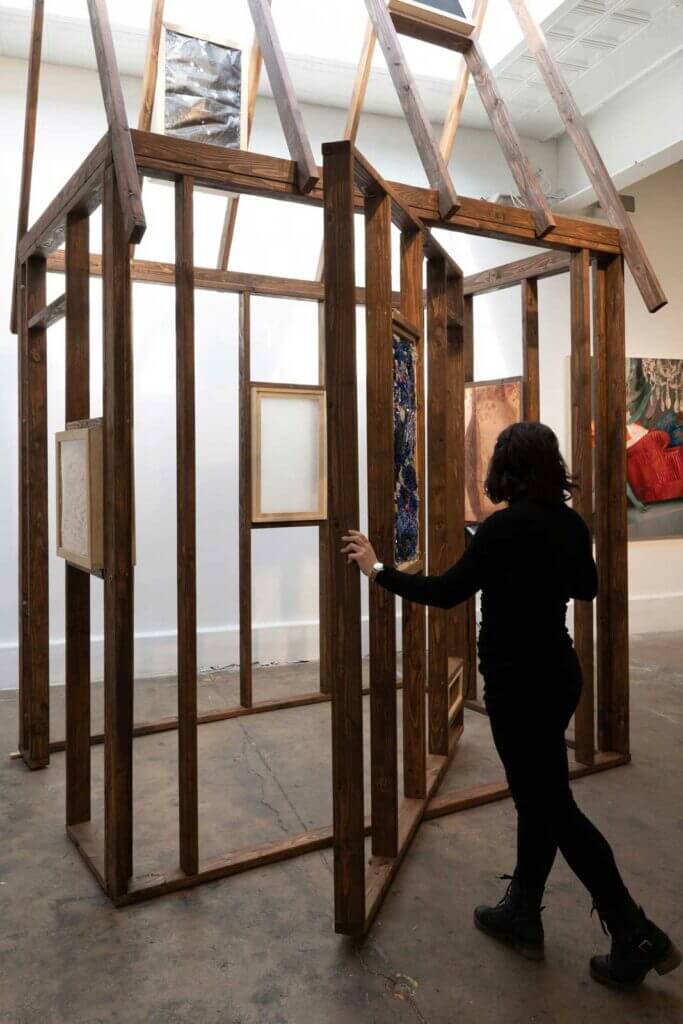
Above: Kenturah Davis, Interface III (2018-2019)5 1/2 x 8 x 14 feet. Mixed media structure. Courtesy of Artist and Matthew Brown Los Angeles. Virginia Harold Photography
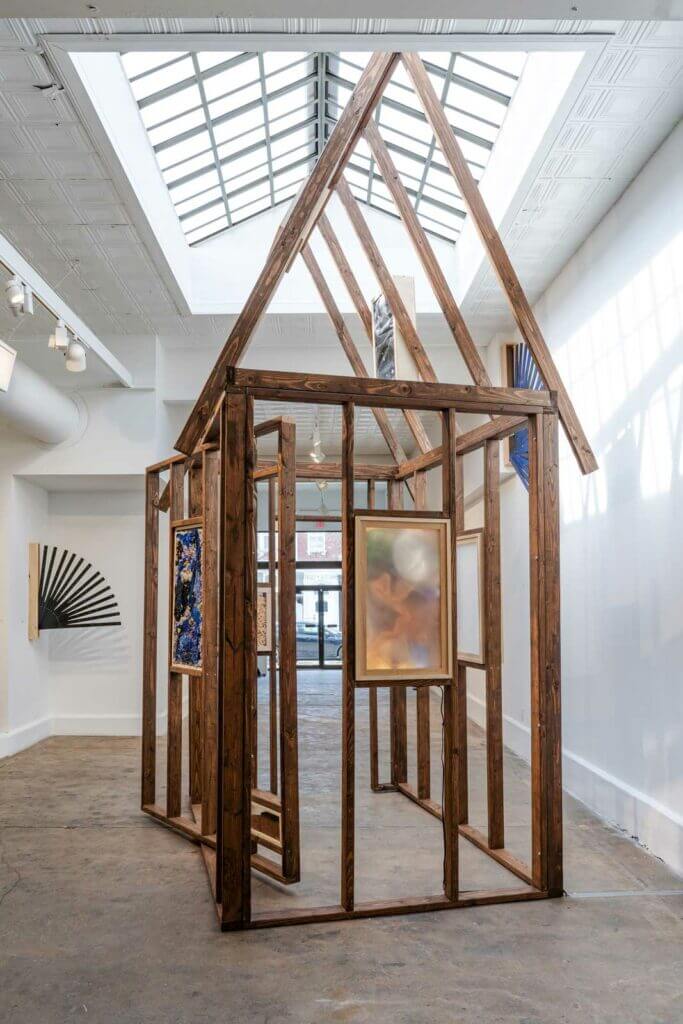
Above: Above: Kenturah Davis, Interface III (2018-2019)5 1/2 x 8 x 14 feet. Mixed media structure. Courtesy of Artist and Matthew Brown Los Angeles. Virginia Harold Photography
Situated across from Davis’s structure is a piece called The Displaced, the work of St Louis native, Basil Kincaid, a mannequin covered in used scratch cards and a cloak of the artist’s signature quilting, a separate work called Special Spot (2019). Kincaid describes his work as being in dialogue with the quotidian and the performative nature of self-presentation. In Ghana, prepaid scratch cards are vouchers created by mobile communication companies that once scratched, reveal coded information that is then loaded on to mobile phone accounts. Once scratched off, these cards are discarded, creating tons of extra waste. The artist has been thinking about concepts of communication, connection and belonging and explained his work further in the following quote.
“All the scratch cards make me think about attempts to call home, so to speak, the desire to connect with a place of origin and home is amplified when stripped from the knowledge of your origin. While in Ghana, I began to consider it to be home, then I called home (the U.S) and felt homesick for a place that never felt like home. Since being in Ghana I’ve been thinking about creating sites of belonging—being able to belong wherever we exist. It all goes back to resourcefulness– taking what we have and making something better from it.”
Queer artists of color have a strong presence in the exhibition, demonstrating Calmese’s attempt to make marginalized artist from different communities more visible, but also paying homage to a community that heavily influences style and fashion. Calmese also made gestures of making quotidian sartorial tropes of Black and Brown presentation iconography.
Jacolby Satterwhite’s 2018 diptych, Anton, elevates a dime store head wrap, the durag into a work of couture embellishment. The piece features two black men passionately kissing. Calmese told St Louis Magazine, “I want to queer the gaze and include that idea as well,” he says. “Black queer voices are something that’s not always visible or we’re not talking about.” The glamour and obscuring of Satterwhite’s diptych talks back to Davis’s house-like structure, Interface III (2018-2019), with the revolving panels, constantly obscuring and presenting at the same time. One of the panels is heavily embellished with beads and embroidery— in dialogue with the glamour of Satterwhite’s durags.

Above: Jacolby Satterwhite Anton (2018) 33 x 50 inches each Chromogenic print, diptych, edition of 3. Image courtesy of the artist and Mitchell-Innes & Nash, New York.
“In a racialized, patriarchal and misogynist America, masculinity or at least a convincing masculine performance, is a prized possession. Highly gendered clothing like suiting, serve as visual and cultural shorthand to imitate and reinforce male prowess.” This quote from the curator directly speaks to one of the subthemes of the exhibition, the fashioning of the masculine identity through the lenses of hyper masculine sartorial performance and the queer body. Calmese notes that these factors are often seen as binaries, but are not mutually exclusive, referencing the hyper masculine street style phenomenon of low sagging jeans (often revealing ass cleavage) as form of seductive sartorial performance. For Calmese, this gesture leads to questions of who this straight identified man is presenting to, since most women do not find the gesture attractive. This curatorial enquiry plays out within the juxtaposing placement of paintings by Fahamu Pecou and David Antonio Cruz.
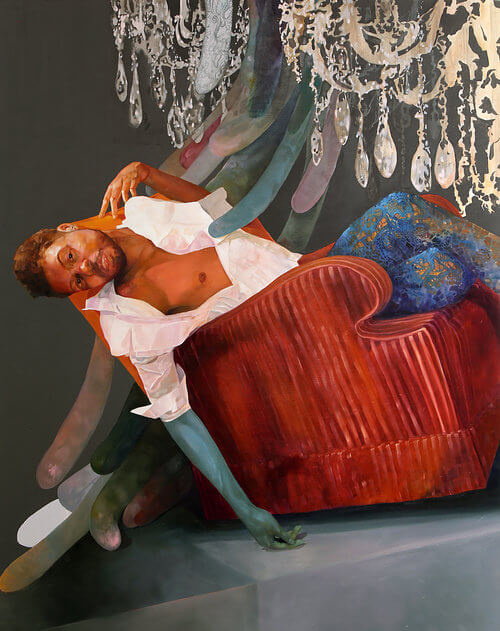
NOTSOPRETTYINTHEFACE
60 x 48 inches
Oil and enamel on wood
Courtesy of the artist and projects+gallery
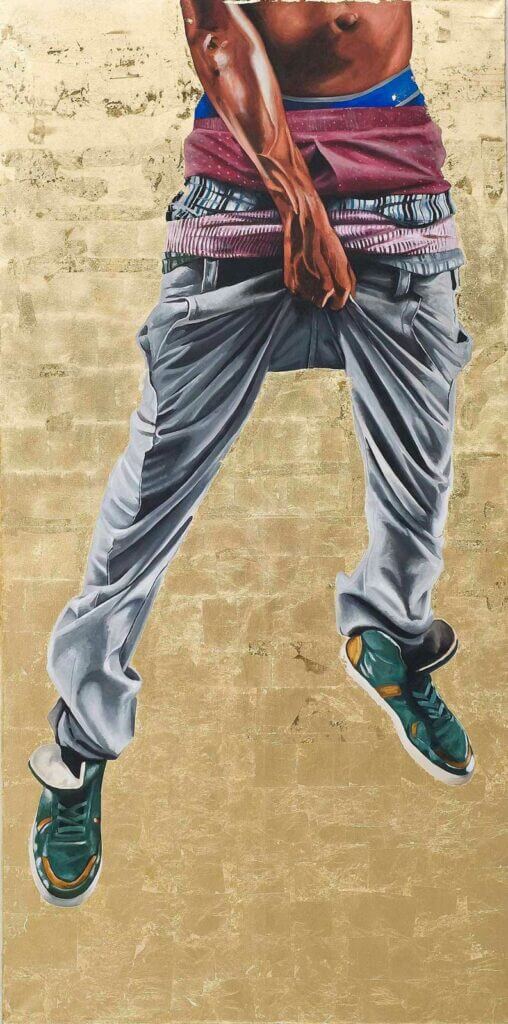
Black Boy Fly (2014)
120 x 60 inches
Acrylic and gold leaf on canvas
Courtesy of projects + gallery
Once viewers have taken in work by household names such as Kehinde Wiley, they are then led to a media room with video installations by Kenturah Davis, and Brooklyn, New York based artist Jacolby Satterwhite. In Reifying Desire/Model It (2016) avideo installation by Satterwhite, images of dancing (Voguing) bodies are celebrated for the intense labor of their performance, while grapping with being harmed by external dangerous elements, and simultaneously laboring to be seen and heard. Satterwhite’s practice addresses themes of labor, consumption, sex and fantasy through this immersive installation, virtual reality and digital media. As stated in Satterwhite’s bio, the artist’s work draws from queer theory, modernism and video game history; Satterwhite uses a range of software to produce intricately detailed animations and live action film of real and imagined worlds populated by the avatars of artists and friends.
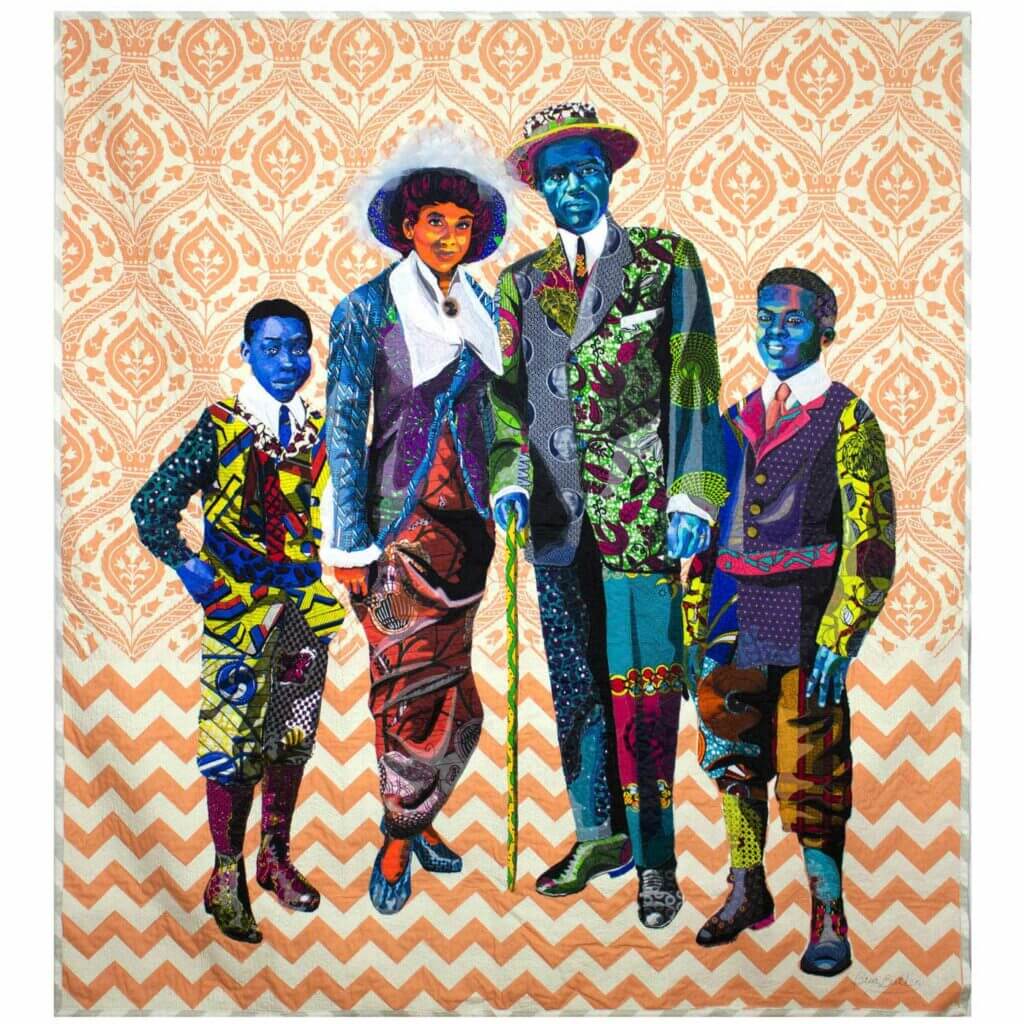
Cotton, silk, and denim
Courtesy of
Dario Calmese leads viewers through a diverse representation of black presentation of style and fashion as mentioned earlier the exhibition has an element of nostalgia, connecting viewers to age old culturally significant materials that are containers of collective memory and experience. Artist Bisa Butler’s work anchors the exhibition Bisa Butler’s Black Star Family, First Class Tickets to Liberia (2018). Like the work of Kincaid, Butler’s work is a contemporary manifestation of African American quilt-making traditions. “Black Star Family depicts a kind of family portraiture serving as a meditation in between the historic and the fantasy. In the tableaux, a dignified and stylish Black family adorned in traditional late 19th century silhouettes, evoke notes of family values, in a pristine “Sunday’s Best” traditional aesthetic. Butler’s quilting appears as a painting connecting African American imaging to West African patterns and motifs found in Dutch Wax textiles of cotton, and silk. The work serves a fabulated document depicting a historic happening of Pan Africanism.
Behind the elegant repose of the captivating work of Butler, lies the connective thread of the exhibition— historically Black and Brown people have used fashion as a kind of armor and weapon. A shield that empowers their movement throughout the world. Although these artists may not have had the concept of fashion foremost in mind while creating these works, fashioning the body comes to the fore because it is deeply imbedded Black and Brown cultural identity; it has been generationally transmitted and will continue to appear.









